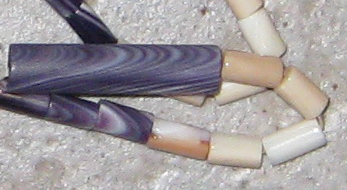 |
| Wampum beads, Wikipedia |
My novel Snakes grew out of years of hearing snake stories, some coming from family stories I heard as a child, and from these relatives who migrated from Stonington, Connecticut, to Old Stonington Colony, Illinois. The following stories were recounted by my great uncle Guy Peabody (b. 1878), son of William Edward Peabody. His grandfather, William Starr Peabody, was one of the founders.
These stories happened after a small lake was drained on the family farm (there are consequences for everything.) Tiles were laid, as they were throughout much of central Illinois, and soon the land was dry enough to begin plowing the soil.
Now this plowing up of this heavy sod started a snake epidemic: rattlesnakes were scattered everywhere. The men wore heavy leather boots coming to their knees and a snake could not bite through.
It was warm weather and I was barefoot and nearly stepped on one if father had not heard it rattle. (They always warn you just before they strike.) and I was right behind him so close he just whirled around and pushed me over backwards as I was just ready to step on the snake.
Mother always kept about 200 hens for eggs and meat. She would feed those hens just about dusk and get the eggs. She had two wire baskets that held about 50 eggs each and I would carry these baskets while she reached in the nests to get the eggs and put them in my basket.
This day happened to be cloudy and while it was light outside it was dark inside the hen house. She had one basket nearly full and would reach in and feel for the eggs, but at one nest she hesitated and says, “Guy, something tells me not to put my hand in that nest. Will you go light our lantern and bring it out and we will see what’s wrong.”
We soon found out, as there lay a rattler all coiled on top of the eggs ready to strike. We passed that nest up and told father, and he and the hired hand took the lantern and shot gun and the hired hand held the lantern so father could see and let loose a load of shot that blew the head off that snake and scared the daylights out of the hens and I thought they never would stop cackling.
Now one more for the record: Lloyd and I were making us a cart out of a dried goods box in our tool shed and I had to go to the house for something just before noon and as I started up the three steps to the kitchen … there lay a big rattler on the second step sunning himself. I called to mother and says, “there’s a snake on the second step so don’t come out!” She grabs the old garden hoe we kept handy and sharp as a razor just for this job only, and she came out another door and around, saw it, and as the snake raised his head to strike the hoe, mother made one strike also and cut off the snake’s head.
I remember how we loved to retell these stories, even almost 100 years later. The fascination with them inspired my first novel Snakes. But I must add, as I wrote the many stories about all this snake killing, they inspired horror. There are no rattlesnakes in central Illinois anymore and the lakes are often man-made. The slough in which we as children ice skated in winter and fished in summer was also drained and now plowed.
And there are other stories too, about the Indians, those people who had lived for millennia in a diversified and verdant way, stories often derogatory in attitude. My uncle was a kind man, yet his recount of the two Indians who came to their farm before he was born looking for something has an edge. The Indians came several times until my great grandfather asked them what they were looking for. “Wampum money,” they replied. “The old chief tells us wampum buried by big tree.” They finally left saying “No find wampum.”
Wampum are traditional sacred white shell beads of the Eastern Woodland tribes.
This land of promise of my relatives is now plowed flat, planted with GMO corn and soybeans, deweeded with glyphosates (Round-Up), the forests and even hedgerows mostly cut to allow for more GMO corn and soybeans. Within 150 years of my ancestors’ arrival, 99% of the virgin prairie of Illinois was gone, along with the prairie chickens, wolves, and populations of ducks and geese, once abundant “by the hundreds.” Recently an industrial cattle farmer was stopped from building his installation near Stonington due to ground water concerns. My relatives living in central Illinois suffer from various autoimmune disorders and you can no longer raise a garden due to overspray, often from aerial spraying of glyphosate and pesticides.
One can only hope that those sacred beads are still under a big tree (hopefully they did not go the way of the snake!) One of these days very soon a child or a farmer may find them, as I one day found the rose quartz in our vineyard (Story is in Farming Soul: A Tale of Initiation.) Then maybe White Shell Woman will smile, and we all will know, we are of one piece, we all are relatives.
